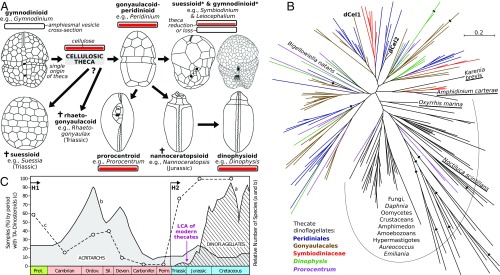Fig. 2.
Thecal evolution and dinoflagellate paleohistory. (A) Phylogeny-driven model of changes between major modern and fossil (crosses) tabulational types. Gymnodinoid tabulation with numerous small, empty amphiesmal vesicles is ancestral and gave rise to the gonyaulacoid–peridinioid tabulation with a few large, cellulose-rich thecal plates. Suessioid and gymnodinioid tabulations in modern Symbiodiniaceae and Borghiellaceae (asterisk) are derived independently of the standard gymnodiniod and Triassic suessioid tabulations (Suessia), and are characterized by decrease or loss of cellulose content. Prorocentroid and dinophysioid tabulations are derived from the gonyaulacoid–peridiniod tabulation (the latter probably via a nannoceratopsioid intermediate). Triassic suessioid and rhaetogonyaulacoid tabulations may represent evolutionary intermediates or independent experiments in thecal plate reduction. (B) Maximum-likelihood phylogeny (IQ-Tree) of 184 eukaryotic GH7 proteins reveals cellulases in athecate dinoflagellates (underlined) and their radiation in the thecate (color-coded). Black rectangles indicate 50% reduction in branch length. Known GH7 cellulases in P. lunula (dCel1) and Lingulodinium polyedrum (dCel2) are shown. Further details are provided in SI Appendix, Fig. S1 and Table S4. (C) Alternative hypotheses (H1 and H2) on the first emergence of triaromatic dinosteranes attributable to dinoflagellates or their direct ancestors (H2 is preferred by our data). Relative species numbers of dinoflagellates (a) and acritarchs (b) and percentage of dinosterane-positive samples (c; see ref. 35 for sample data) from the Proterozoic (green), Paleozoic (red), and Mesozoic (blue) are shown together with the predicted emergence of the last common ancestor (LCA) of modern thecates. Reprinted with permission from refs. 26, 28 (www.sciencedirect.com/science/journal/14344610), 35 (permission conveyed through Copyright Clearance Center, Inc.), and 74.

